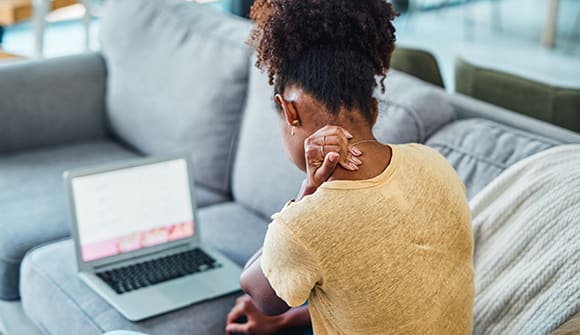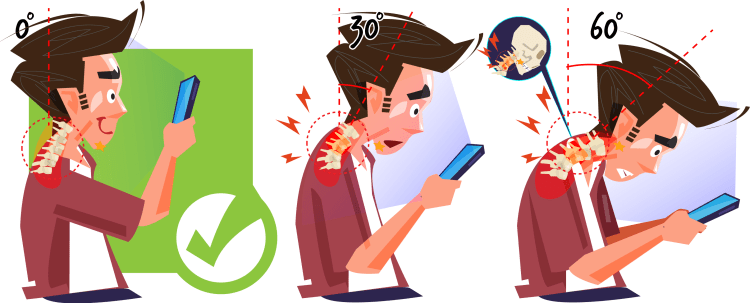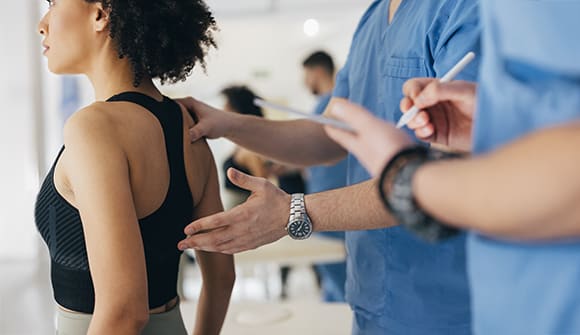Heads up
Technology can be a pain in the neck.
Article Date:

In today's screen-heavy world, where many people spend most of their day bent over their phone, tablet or computer, aches and pains in the neck, head and shoulders are inevitable. These ailments, commonly known as "tech neck," are caused by repetitive strain and injury to the muscles and other tissue structures of the neck portion of the spine (called the cervical spine). The pandemic's increase in the work-from-home model only increased the problem.
"Many people didn't have a proper desk setup and worked on laptops at kitchen tables, on the couch or in bed. None of these promote proper neck ergonomics and mechanics," explained Ehren Allen, DPT, a physical therapist.
The most common complaints associated with tech neck are:
- Shoulder and/or upper-neck pain
- Stiffness
- Soreness
- Headaches (usually in the base of the head or radiating to the forehead and eye)
- Neck spasms
- Pain between the shoulder blades
- Creaky shoulder joints
In more severe cases, bulging or ruptured disks in the spine may pinch nerves in the neck causing numbness, tingling or weakness in the arms or hands, which could require surgery for a permanent repair.
Heavy head
What causes this damage?
"With tech neck, most people are slumped in a chair with the lower part of the neck flexed forward and the upper part extended in a forward position. This places excessive, abnormal force on the lower discs and joints, and compresses the upper joints and soft tissue," explained Allen.
An adult head weighs about 10-12 pounds in a neutral position. As the head tilts forward, the strain on the neck increases, with the impact equivalent to 50-60 pounds at some angles.

Holding your neck at a 45-degree angle for an extended amount of time is equivalent to the work required to hold a 50-pound bag of oranges.
Ease the pain
We know screens aren't going away. The good news is, there are ways to help prevent or alleviate the aches and pains associated with tech neck:
- Move. "Take stretch breaks every 30 minutes to move the neck and back," recommended Allen. Even if it's only for a minute, it will get blood circulating and move your neck in a different position.
- Sit up. "The pelvis and lower back need to be in an erect position to allow the rest of the spine to maintain a neutral position," said Allen. "The shoulder blades should be back and the neck upright." The proper position will have your chin parallel to the floor.
- Stand up. Allen recommends adjustable standing workstations to his patients, and finds most employers are willing to accommodate the request. "Standing places the body in a better position for proper postural alignment," said Allen. "I recommend switching between standing and sitting throughout the day."
- Exercise. Do some form of aerobic activity that doesn't cause neck pain. Examples include using an elliptical or stationary bicycle, jogging, swimming or brisk walking. Exercise sends oxygenated blood to tired muscles, which helps drain the chemicals that cause inflammation and pain. It can also help strengthen your core, ease tension in the muscles and mitigate weight gain. "Obesity can increase abnormal stresses on the spine," said Allen.
- Get in line. "If you're using a laptop, try getting a separate keyboard and mouse so the monitor is at eye level and you don't need to reach to use the accessories. If you're working from home, have a designated workstation that is properly set up based on the tips above," recommended Allen. When using phones or tablets, bring them to eye level instead of bending your head to read them.
- Focus. "Proper eyewear can help. Straining to see the screen can affect neck posture."
Doctor time?
Allen said the general aches and pains of tech neck should be manageable by implementing the recommendations above, along with maintaining regular exercise and stretching. However, if the headaches don't quickly resolve, the pain doesn't improve with gentle movement and workstation modifications, or the symptoms worsenand/or progress into the shoulder blade or arms, it's time to see a doctor.
If you’re experiencing back or neck pain, speak with your primary care physician, who can make a referral to an orthopedic specialist. To find the right provider for you, call 904.202.4YOU(4968) or fill out the appointment request form.



